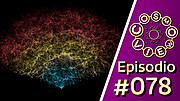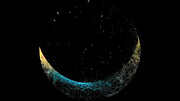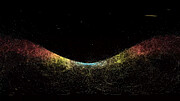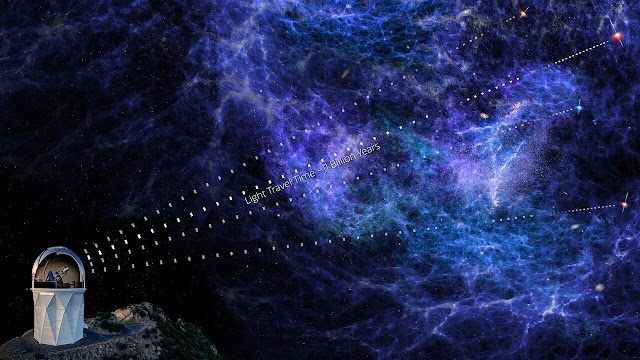PR Image noirlab2408a
Artistic Composition of DESI Year-One Data Slice Above the Nicholas U. Mayall 4-meter Telescope
Artistic Composition of DESI Year-One Data Slice Above the Nicholas U. Mayall 4-meter Telescope
PR Image noirlab2408b
DESI Year-One Data Slice
DESI Year-One Data Slice
PR Image noirlab2408c
DESI Year-One Data Slice (annotated)
DESI Year-One Data Slice (annotated)
PR Image noirlab2408d
DESI Uses Distant Quasars to Map the Cosmic Web

PR Video noirlab2408h
Cosmoview Episodio 78: Revelan detallada panorámica de 11 mil millones de años hacia el pasado del Universo

PR Video noirlab2408b
DESI Slice Fly-through

PR Video noirlab2408c
DESI Slice Rotation

PR Video noirlab2408d
Baryon Acoustic Oscillations Left Over From the Nascent Universe

PR Video noirlab2408e
Nicholas U. Mayall 4-meter Telescope Interior

PR Video noirlab2408f
Fulldome DESI Slice Fly-through

PR Video noirlab2408g
SOS/Equirectangular DESI Slice Fly-through
DESI Uses Distant Quasars to Map the Cosmic Web
PR Image noirlab2408g
The Dark Energy Spectroscopic Instrument Installed on the Nicholas U. Mayall 4-meter Telescope
The Dark Energy Spectroscopic Instrument Installed on the Nicholas U. Mayall 4-meter Telescope
Videos
Cosmoview Episode 78: DESI Looks 11 Billion Years Into the Past to Reveal Most Detailed View Ever of the Expanding Universe

PR Video noirlab2408h
Cosmoview Episodio 78: Revelan detallada panorámica de 11 mil millones de años hacia el pasado del Universo

PR Video noirlab2408b
DESI Slice Fly-through

PR Video noirlab2408c
DESI Slice Rotation

PR Video noirlab2408d
Baryon Acoustic Oscillations Left Over From the Nascent Universe

PR Video noirlab2408e
Nicholas U. Mayall 4-meter Telescope Interior

PR Video noirlab2408f
Fulldome DESI Slice Fly-through

PR Video noirlab2408g
SOS/Equirectangular DESI Slice Fly-through
Using first-year data from the Dark Energy Spectroscopic Instrument Survey, astronomers have reported unprecedented measurements of dark energy and its effect on the expanding Universe
The Dark Energy Spectroscopic Instrument
is conducting a five-year survey to create the largest 3D map of the
Universe ever. Astronomers are now performing initial analysis of the
survey’s first-year data. Using spectra of nearby galaxies and distant
quasars, astronomers report that they have measured the expansion
history of the Universe with the highest precision ever, providing an
unprecedented look at the nature of dark energy and its effect on the
Universe's large-scale structure.
Since beginning its survey of the sky in 2021 the Dark Energy Spectroscopic Instrument (DESI) has observed a new set of 5000 galaxies every 20 minutes, totalling more than 100,000 galaxies per night, in its quest to create the largest 3D map of the Universe ever. Using the survey’s first-year data, which contains the largest extragalactic spectroscopic sample ever collected, astronomers report that they have measured the Universe’s expansion history over the last 11 billion years with a precision better than 1%. These measurements confirm the basics of our best model of the Universe, while also uncovering some tantalizing areas to explore with more data.
DESI is an international science collaboration of more than 900 researchers from over 70 institutions around the world. DESI is managed by the U.S. Department of Energy’s Lawrence Berkeley National Laboratory (LBNL) with primary funding from the Department’s Office of Science. The instrument is mounted on the U.S. National Science Foundation Nicholas U. Mayall 4-meter Telescope at Kitt Peak National Observatory, a Program of NSF NOIRLab.
To map the cosmos, DESI collects light from millions of galaxies across more than a third of the entire sky. By breaking down the light from each galaxy into its spectrum of colors, DESI can determine how much the light has been redshifted, or stretched to a longer wavelength, by the expansion of the Universe during the billions of years it traveled before reaching Earth. In general, the higher the redshift the further away the galaxy is.
Equipped with 5000 tiny robotic ‘eyes,’ DESI is able to perform this measurement at an unprecedented rate. In its first year alone DESI surpassed all previous surveys of its kind in terms of quantity and quality. With incredible depth and precision, DESI has brought new insight to one of the biggest mysteries in physics: dark energy — the unknown ingredient causing the expansion of our Universe to accelerate [1].
“The DESI instrument has transformed the Mayall Telescope into the world’s premier cosmic cartography machine,” says Pat McCarthy, Director of NOIRLab. “The DESI team has set a new standard for studies of large-scale structure in the Universe. These first-year data are only the beginning of DESI’s quest to unravel the expansion history of the Universe and they hint at the extraordinary science to come."
DESI’s first-year data have allowed astronomers to measure the expansion rate of the Universe out to 11 billion years in the past, when the Universe was only a quarter of its current age, using a feature of the large-scale structure of the Universe called Baryon Acoustic Oscillations (BAO).
BAO are the leftover imprint of pressure waves that permeated the early Universe when it was nothing but a hot, dense soup of subatomic particles. As the Universe expanded and cooled the waves stagnated, freezing the ripples in place and seeding future galaxies in the dense areas. This pattern, resembling the rippling surface of a pond after a handful of pebbles is tossed in, can be seen in DESI’s detailed map, which shows strands of galaxies clustered together, separated by voids where there are fewer objects.
At a certain distance, the BAO pattern becomes too faint to detect using typical galaxies. So instead astronomers look at the ‘shadow’ of the pattern as it’s backlit by extremely distant, bright galactic cores known as quasars. As the quasars’ light travels across the cosmos it gets absorbed by intergalactic clouds of gas, allowing astronomers to map the pockets of dense matter. To implement this technique, researchers used 450,000 quasars — the largest set ever collected for this type of study.
With DESI’s unique ability to map millions of objects both near and far, the BAO pattern can be used as a cosmic ruler. By mapping nearby galaxies and distant quasars, astronomers can measure the spread of the ripples across several periods of cosmic history to see how dark energy has stretched the scale over time.
“We’re incredibly proud of the data, which have produced world-leading cosmology results,” said Michael Levi, DESI director and LBNL scientist. “So far we’re seeing basic agreement with our best model of the Universe, but we’re also seeing some potentially interesting differences that could indicate dark energy is evolving with time.”
While the expansion history of the Universe may be more complex than previously imagined, confirmation of this must await the completion of the DESI project. By the end of its five-year survey DESI plans to map over 3 million quasars and 37 million galaxies. As more data are released, astronomers will further improve their results.
“This project is addressing some of the biggest questions in astronomy, like the nature of the mysterious dark energy that drives the expansion of the Universe,” says Chris Davis, NSF program director for NOIRLab. “The exceptional and continuing results yielded by the NSF Mayall telescope with DOE DESI will undoubtedly drive cosmology research for many years to come.”
“We are delighted to see cosmology results from DESI's first year of operations," said Gina Rameika, associate director for High Energy Physics at the Department of Energy. "DESI continues to amaze us with its stellar performance and how it is shaping our understanding of dark energy in the Universe."
Data from DESI’s survey will work harmoniously with future sky surveys conducted by Vera C. Rubin Observatory and the Nancy Grace Roman Space Telescope, with each instrument’s strength complementing the others. The DESI collaboration is currently investigating potential upgrades to the instrument and planning to expand their cosmological exploration into a second phase, DESI-II, as recommended in a recent report by the U.S. Particle Physics Project Prioritization Panel.
While the DESI year-one data are not yet publicly available, researchers can access the early data release as searchable databases of catalogs and spectra via the Astro Data Lab and SPARCL at the Community Science and Data Center, a Program of NSF NOIRLab.
Since beginning its survey of the sky in 2021 the Dark Energy Spectroscopic Instrument (DESI) has observed a new set of 5000 galaxies every 20 minutes, totalling more than 100,000 galaxies per night, in its quest to create the largest 3D map of the Universe ever. Using the survey’s first-year data, which contains the largest extragalactic spectroscopic sample ever collected, astronomers report that they have measured the Universe’s expansion history over the last 11 billion years with a precision better than 1%. These measurements confirm the basics of our best model of the Universe, while also uncovering some tantalizing areas to explore with more data.
DESI is an international science collaboration of more than 900 researchers from over 70 institutions around the world. DESI is managed by the U.S. Department of Energy’s Lawrence Berkeley National Laboratory (LBNL) with primary funding from the Department’s Office of Science. The instrument is mounted on the U.S. National Science Foundation Nicholas U. Mayall 4-meter Telescope at Kitt Peak National Observatory, a Program of NSF NOIRLab.
To map the cosmos, DESI collects light from millions of galaxies across more than a third of the entire sky. By breaking down the light from each galaxy into its spectrum of colors, DESI can determine how much the light has been redshifted, or stretched to a longer wavelength, by the expansion of the Universe during the billions of years it traveled before reaching Earth. In general, the higher the redshift the further away the galaxy is.
Equipped with 5000 tiny robotic ‘eyes,’ DESI is able to perform this measurement at an unprecedented rate. In its first year alone DESI surpassed all previous surveys of its kind in terms of quantity and quality. With incredible depth and precision, DESI has brought new insight to one of the biggest mysteries in physics: dark energy — the unknown ingredient causing the expansion of our Universe to accelerate [1].
“The DESI instrument has transformed the Mayall Telescope into the world’s premier cosmic cartography machine,” says Pat McCarthy, Director of NOIRLab. “The DESI team has set a new standard for studies of large-scale structure in the Universe. These first-year data are only the beginning of DESI’s quest to unravel the expansion history of the Universe and they hint at the extraordinary science to come."
DESI’s first-year data have allowed astronomers to measure the expansion rate of the Universe out to 11 billion years in the past, when the Universe was only a quarter of its current age, using a feature of the large-scale structure of the Universe called Baryon Acoustic Oscillations (BAO).
BAO are the leftover imprint of pressure waves that permeated the early Universe when it was nothing but a hot, dense soup of subatomic particles. As the Universe expanded and cooled the waves stagnated, freezing the ripples in place and seeding future galaxies in the dense areas. This pattern, resembling the rippling surface of a pond after a handful of pebbles is tossed in, can be seen in DESI’s detailed map, which shows strands of galaxies clustered together, separated by voids where there are fewer objects.
At a certain distance, the BAO pattern becomes too faint to detect using typical galaxies. So instead astronomers look at the ‘shadow’ of the pattern as it’s backlit by extremely distant, bright galactic cores known as quasars. As the quasars’ light travels across the cosmos it gets absorbed by intergalactic clouds of gas, allowing astronomers to map the pockets of dense matter. To implement this technique, researchers used 450,000 quasars — the largest set ever collected for this type of study.
With DESI’s unique ability to map millions of objects both near and far, the BAO pattern can be used as a cosmic ruler. By mapping nearby galaxies and distant quasars, astronomers can measure the spread of the ripples across several periods of cosmic history to see how dark energy has stretched the scale over time.
“We’re incredibly proud of the data, which have produced world-leading cosmology results,” said Michael Levi, DESI director and LBNL scientist. “So far we’re seeing basic agreement with our best model of the Universe, but we’re also seeing some potentially interesting differences that could indicate dark energy is evolving with time.”
While the expansion history of the Universe may be more complex than previously imagined, confirmation of this must await the completion of the DESI project. By the end of its five-year survey DESI plans to map over 3 million quasars and 37 million galaxies. As more data are released, astronomers will further improve their results.
“This project is addressing some of the biggest questions in astronomy, like the nature of the mysterious dark energy that drives the expansion of the Universe,” says Chris Davis, NSF program director for NOIRLab. “The exceptional and continuing results yielded by the NSF Mayall telescope with DOE DESI will undoubtedly drive cosmology research for many years to come.”
“We are delighted to see cosmology results from DESI's first year of operations," said Gina Rameika, associate director for High Energy Physics at the Department of Energy. "DESI continues to amaze us with its stellar performance and how it is shaping our understanding of dark energy in the Universe."
Data from DESI’s survey will work harmoniously with future sky surveys conducted by Vera C. Rubin Observatory and the Nancy Grace Roman Space Telescope, with each instrument’s strength complementing the others. The DESI collaboration is currently investigating potential upgrades to the instrument and planning to expand their cosmological exploration into a second phase, DESI-II, as recommended in a recent report by the U.S. Particle Physics Project Prioritization Panel.
While the DESI year-one data are not yet publicly available, researchers can access the early data release as searchable databases of catalogs and spectra via the Astro Data Lab and SPARCL at the Community Science and Data Center, a Program of NSF NOIRLab.
Notes
[1] As an organization, NOIRLab has committed decades of research to dark matter and dark energy
measurements, with multiple NOIRLab-operated telescopes, including the
Nicholas U. Mayall 4-meter Telescope, contributing to ground-breaking discoveries in these areas, one of which received the 2011 Nobel Prize in Physics
More information
Researchers shared the analysis of their
first year of collected data in several papers that will be posted today
on the arXiv and in talks at the American Physical Society Meeting in
the U.S. and the Rencontres de Moriond in Italy.
DESI is supported by the DOE Office of Science and by the National Energy Research Scientific Computing Center, a DOE Office of Science user facility. Additional support for DESI is provided by the U.S. National Science Foundation, the Science and Technology Facilities Council of the United Kingdom, the Gordon and Betty Moore Foundation, the Heising-Simons Foundation, the French Alternative Energies and Atomic Energy Commission (CEA), the National Council of Science and Technology of Mexico, the Ministry of Science and Innovation of Spain, and by the DESI member institutions.
The DESI collaboration is honored to be permitted to conduct scientific research on Iolkam Du’ag (Kitt Peak), a mountain with particular significance to the Tohono O’odham Nation.
NSF NOIRLab (U.S. National Science Foundation National Optical-Infrared Astronomy Research Laboratory), the U.S. center for ground-based optical-infrared astronomy, operates the International Gemini Observatory (a facility of NSF, NRC–Canada, ANID–Chile, MCTIC–Brazil, MINCyT–Argentina, and KASI–Republic of Korea), Kitt Peak National Observatory (KPNO), Cerro Tololo Inter-American Observatory (CTIO), the Community Science and Data Center (CSDC), and Vera C. Rubin Observatory (operated in cooperation with the Department of Energy’s SLAC National Accelerator Laboratory). It is managed by the Association of Universities for Research in Astronomy (AURA) under a cooperative agreement with NSF and is headquartered in Tucson, Arizona. The astronomical community is honored to have the opportunity to conduct astronomical research on I’oligam Du’ag (Kitt Peak) in Arizona, on Maunakea in Hawai‘i, and on Cerro Tololo and Cerro Pachón in Chile. We recognize and acknowledge the very significant cultural role and reverence that these sites have to the Tohono O’odham Nation, to the Native Hawaiian community, and to the local communities in Chile, respectively.
DESI is supported by the DOE Office of Science and by the National Energy Research Scientific Computing Center, a DOE Office of Science user facility. Additional support for DESI is provided by the U.S. National Science Foundation, the Science and Technology Facilities Council of the United Kingdom, the Gordon and Betty Moore Foundation, the Heising-Simons Foundation, the French Alternative Energies and Atomic Energy Commission (CEA), the National Council of Science and Technology of Mexico, the Ministry of Science and Innovation of Spain, and by the DESI member institutions.
The DESI collaboration is honored to be permitted to conduct scientific research on Iolkam Du’ag (Kitt Peak), a mountain with particular significance to the Tohono O’odham Nation.
NSF NOIRLab (U.S. National Science Foundation National Optical-Infrared Astronomy Research Laboratory), the U.S. center for ground-based optical-infrared astronomy, operates the International Gemini Observatory (a facility of NSF, NRC–Canada, ANID–Chile, MCTIC–Brazil, MINCyT–Argentina, and KASI–Republic of Korea), Kitt Peak National Observatory (KPNO), Cerro Tololo Inter-American Observatory (CTIO), the Community Science and Data Center (CSDC), and Vera C. Rubin Observatory (operated in cooperation with the Department of Energy’s SLAC National Accelerator Laboratory). It is managed by the Association of Universities for Research in Astronomy (AURA) under a cooperative agreement with NSF and is headquartered in Tucson, Arizona. The astronomical community is honored to have the opportunity to conduct astronomical research on I’oligam Du’ag (Kitt Peak) in Arizona, on Maunakea in Hawai‘i, and on Cerro Tololo and Cerro Pachón in Chile. We recognize and acknowledge the very significant cultural role and reverence that these sites have to the Tohono O’odham Nation, to the Native Hawaiian community, and to the local communities in Chile, respectively.
Links
- Read the DESI Y1 papers
- Visit the Dark Energy Spectroscopic Instrument webpage
- Access DESI Early-Release data
- Images of DESI
- Videos of DESI
- Images of Nicholas U. Mayall 4-meter telescope
- Videos of Nicholas U. Mayall 4-meter telescope
- Check out other NOIRLab Organization Releases
- Lawrence Berkeley National Laboratory press release
Contacts
Arjun Dey
NSF NOIRLab
Email:arjun.dey@noirlab.edu
Nathalie Palanque-Delabrouille
Lawrence Berkeley National Laboratory
DESI Co-spokesperson
Email:npalanque-delabrouille@lbl.gov
Kyle Dawson
University of Utah
DESI Co-spokesperson
Email: kdawson@astro.utah.edu
Eric Linder
Lawrence Berkeley National Laboratory
DESI Press Committee Chair
Email:evlinder@lbl.gov
Josie Fenske
Jr. Public Information Officer
NSF NOIRLab
Email:josie.fenske@noirlab.edu
Lauren Biron
Lawrence Berkeley National Laboratory
Science Communication and Media Relations Specialist
Email:LBiron@lbl.gov
Arjun Dey
NSF NOIRLab
Email:arjun.dey@noirlab.edu
Nathalie Palanque-Delabrouille
Lawrence Berkeley National Laboratory
DESI Co-spokesperson
Email:npalanque-delabrouille@lbl.gov
Kyle Dawson
University of Utah
DESI Co-spokesperson
Email: kdawson@astro.utah.edu
Eric Linder
Lawrence Berkeley National Laboratory
DESI Press Committee Chair
Email:evlinder@lbl.gov
Josie Fenske
Jr. Public Information Officer
NSF NOIRLab
Email:josie.fenske@noirlab.edu
Lauren Biron
Lawrence Berkeley National Laboratory
Science Communication and Media Relations Specialist
Email:LBiron@lbl.gov







